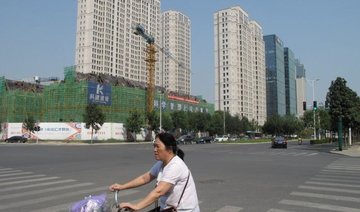Yang Xiaodao, a 26-year-old civil servant in the Chinese city of Xiamen, said taking out a 30-year-mortgage on a two-bedroom apartment with her husband was the most regrettable decision of her life.
Although their parents covered the 1.5 million yuan ($226,778) down payment on the 2.9 million yuan flat, mortgage payments eat up more than 70 percent of the couple’s combined income of about 10,000 yuan a month — average for the city.
“Our spending power has plummeted,” Yang said. “We do not dare to have a kid. We do not dare to buy a car. We do not dare to travel.”
Throughout China, home prices that are among the highest in the world relative to incomes have pushed millions of households to debt levels similar to those seen in the US just before its housing crisis, according to a new study by the Institute for Advanced Research at the Shanghai University of Finance and Economics.
Economists are sounding the alarm that such debt has started to crimp consumption.
Wang Jun, chief economist at Zhongyuan Bank in Beijing, said slowing income growth and high household borrowing levels will limit how much consumers can boost economic growth in the short term.
“Pressure from mortgages is impacting the amount of disposable income available to spend elsewhere,” he said.
Xiamen, a prosperous coastal city in Fujian province, stands out: Its 4 million residents are the most indebted of any large city in China, according to a Reuters analysis of central bank data.
Known for warm weather, seafood, and a laid-back lifestyle, Xiamen is the fourth-most-expensive real estate market in the country, despite incomes significantly lower than in cities with comparable home prices.
“An influx of property speculators from other cities in the province attracted to Xiamen’s lifestyle drove property prices to record highs, causing panic buying among locals,” said Wang Yanwu, an assistant professor at Xiamen University’s School of Economics.
Xiamen is now crowded with recently built high-rises, and the local government is promoting development in surrounding districts off the main island.
The city’s new home prices increased 53 percent from 2015 through June, or about 19 percent annually, the most among 70 cities tracked by China’s National Bureau of Statistics. Disposable income growth in Xiamen averaged 8.4 percent in the same period.
Nationwide, new home prices have risen 20.7 percent since 2015, according to Reuters calculations based on official data.
But in an alarming sign for homeowners like Yang, home sales in Xiamen slumped after new rules restricted purchases and prices of existing homes fell 4.8 percent in the year to June, compared with a 3.9 percent average increase for 70 large cities in the same period, according to Reuters calculations.
The affordability gap is wide in Xiamen: a 90-square-meter home costs on average 3 million yuan, or $450,000, while per capita income in the city is about $7,500 per year.
Even if buyers can afford a mortgage payment, at least 30 percent of the value of a home is often required up front. At the average price, that equals 60 years’ worth of disposable income.
A 28-year-old father of two, who wanted to be identified only by his surname, Huang, said his parents and in-laws provided his down payment of 2 million yuan last year. But, he added, an 8,000 yuan monthly mortgage leaves little to spend on anything else.
“I feel frustrated, exhausted and annoyed,” Huang said.
The ratio of household debt in Xiamen hit 98 percent of GDP at the end of 2017, much higher than the national level of 55 percent, and higher than the US household debt ratio of 79 percent of GDP, according to the Bank of International Settlements.
And the ratio of household debt to household savings in Xiamen is a staggering 182 percent.
“I am definitely worried” about economic growth in the second half of the year, said Zhongyuan’s Wang. “There is a very good chance that consumption will continue to weaken.”
Retail sales in Xiamen through the first five months of the year increased 9.2 percent versus a year ago, below the national rate of 9.5 percent and significantly slower than the 12.1 percent registered in the same period a year ago.
More than half of large department stores and supermarkets in Xiamen saw a decline in revenue in the first quarter, data from the Xiamen statistics bureau showed.
And data for April showed spending in Xiamen on discretionary items, including cosmetics and jewelry, fell compared with the same period last year.
Throughout the country, per capita disposable income growth slowed to 6.6 percent in the first half of the year compared with 7 percent in the same period a year ago, according to statistics released on July 16.
Debt is piling up in other cities too; in Shenzhen, household borrowing is 79 percent of GDP, and in Hangzhou it is 77 percent.
A Reuters analysis based on central bank data shows residents in the coastal powerhouse cities that drive China’s economy borrow the most, with the highest ratio of outstanding household debt to savings in the province of Fujian, where it hit 110 percent at the end of April, followed by Zhejiang and Guangdong.
The Shanghai University of Finance and Economics report estimated the ratio of household debt to disposable income in China was 78 percent at the end of 2017.
Based on current trends, that will top 100 percent by 2020 — on par with levels in the US before the global financial crisis, according to the report.
The ratio is already higher than the US pre-crisis levels in Fujian, Guangdong, and Zhejiang provinces, three of the richest in the country, according to the report.
“We do not even dare to spend money,” said Yang, the civil servant in Xiamen. “The mortgage has impacted the quality of life for two generations of our family.”



























